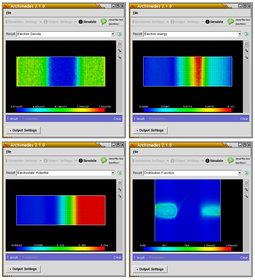GNU Archimedes
This article has multiple issues. Please help improve it or discuss these issues on the talk page. (Learn how and when to remove these template messages)
|
GNU project | |
| Stable release | 2.0.1[1]
/ 30 April 2013 |
|---|---|
UNIX | |
| Type | TCAD |
| License | 2007: GPL-3.0-or-later[a] 2004: GPL-2.0-or-later[b] |
| Website | gnu |
Archimedes is a
The
Introduction
Archimedes is the GNU package for semiconductor device simulations that has been released for the first time on 2005 under GPL. It has been created by Jean Michel Sellier who is, since then, the leader of the project and the main developer. It is a free software and thus it can be copied, modified and redistributed under GPL.
Archimedes belongs to the well-known family of TCAD software, i.e. tools utilized to assist the development of technologically relevant products. In particular, this package assists engineers in designing and simulating submicron and
Archimedes is also useful for teaching purposes since everybody can access the sources, modify and test them. Today, it is used for teaching courses in several hundreds universities all around the world. Furthermore, a simplified version, developed for students, is available on nanoHUB.org.
The Ensemble Monte Carlo method is the method that Archimedes uses to simulate and predict the behavior of a devices. Being the Monte Carlo very stable and reliable, Archimedes can be used to know the characteristics of a device even before this last is built.
The physics and geometry of a device is described simply by a script, which makes, in this sense, Archimedes a powerful tool for the simulation of quite general semiconductor devices.[6]
Archimedes is able to simulate a plenty of physics effects and transport for electrons and heavy holes in Silicon, Germanium, GaAs, InSb, AlSb, AlAs, AlxInxSb, AlxIn(1-x)Sb, AlP, AlSb, GaP, GaSb, InP and their compounds (III-V semiconductor materials), along with Silicon Oxide, the applied and/or self-consistent electrostatic and magnetic fields by means of Poisson and Faraday equation. It is also able to deal with heterostructures.
Boltzmann transport equation
The
The
Monte Carlo method
The semiclassical
where F is the electric field, E(k) is the energy dispersion relation, and k is the momentum wave vector. To solve the above equation, one needs strong knowledge of the band structure (E(k)). The E(k) relation describes how the particle moves inside the device, in addition to depicting useful information necessary for transport such as the density of states (DOS) and the particle velocity. A Full-band E(K) relation can be obtained using the semi-empirical pseudopotential method.[7]
Screenshots
-
A simple 2D diode simulation using Archimedes. The diode is a simple n+-n-n+ structure, the channel length being equal to 0.4 micron. The diode has two n+ regions of 0.3 micron (i.e. the total length is 1.0 micron ). The density in the doping regions are n+=1.e23/m^3 and n=1.e21/m^3 respectively. The applied voltage is equal to 2.0 Volts.
-
A 2D Silicon MESFET simulation using Archimedes. Archimedes takes into account all the relevant scattering mechanisms.
Notes
References
- ^ "Archimedes 2.0.1 has been released". 30 April 2013.
- ^ « Aeneas », gnu.org, May 2012.
- ^ Sellier, Jean Michel (2012-05-13). "Aeneas new release" (Mailing list). info-gnu. Retrieved 2012-05-13.
- ^ E. Wigner, On the Quantum Correction for Thermodynamic Equilibrium (1932)
- ^ J.M. Sellier, http://www.nano-archimedes.com
- ^ "ALT Linux - p9 - archimedes-2.0.1-alt1_11 - 2D Quantum Monte Carlo simulator for semiconductor devices". packages.altlinux.org. Retrieved 2023-06-20.
- ^ K. Hess, Monte Carlo Device Simulation: Full Band and Beyond, Technology (1991)

![{\displaystyle {\frac {\partial f}{\partial t}}+{\frac {1}{\hbar }}\nabla _{k}E(k)\nabla _{r}f+{\frac {qF(r)}{\hbar }}\nabla _{k}f=\left[{\frac {\partial f}{\partial t}}\right]_{\mathrm {collision} }}](https://wikimedia.org/api/rest_v1/media/math/render/svg/b582a61b2d32aaf14276a4d5003e68d2f5f567b1)




